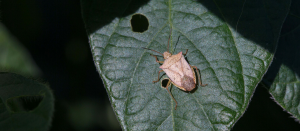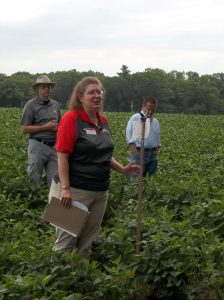Homepage Slider, Soybean Quality
2020 Field Crop Insect Recap
By Dusty Sonnenberg, CCA, Ohio Field Leader: a project of the Ohio Soybean Council and soybean checkoff.
2020 was a year of uneasiness for farmers in Ohio due to weather stress. Many areas in the state experienced various level of abnormally dry to drought conditions during the summer months. While some areas received timely rains, others often saw hit and miss rain shower activity. Given the moisture stress on crops, many growers in Ohio were fortunate that additional stress from insect pressure was not a large factor. Familiar insect pests such as soybean aphids and brown marmorated stinkbugs, or the common defoliators such as be an leaf beetles, Japanese beetle adults and grass hoppers, were present, but not in numbers that were problematic in most situations.
an leaf beetles, Japanese beetle adults and grass hoppers, were present, but not in numbers that were problematic in most situations.
Dr. Kelley Tilmon, Associate Professor and State Specialist for field crop entomology at The Ohio State University reported a year with less pressure than in the past. “Overall, it was quiet on the insect front this past season in Ohio, which is good since the world was not very quiet. We had average or below average levels of the typical problems,” said Tilmon.
There are instances where dry weather concerns can cause enhanced insect pressure. “It looked for a time there like grasshoppers were getting a bit out of control, and I was concerned that we would see spider mite outbreaks,” said Tilmon. “Both of these are associated with dry conditions, which we had for some time. But we got enough shots of rain at enough key times to dampen down those threats. Individuals may still have experience problems, but we did not see statewide outbreaks.”

Another pest on the radar of Ohio State Entomologists and Extension Educators is the Western Bean Cutworm (WBC). “In our Western Bean Cutworm monitoring network (which is actually a pest of corn), we saw the lowest levels of WBC since my program has been tracking it, and this is our 5th season,” said Tilmon.
The Soybean gall midge is another and new pest that researchers have been on the look-out for. “The Soybean gall midge larvae damage crops by feeding on the inside of the stem, cutting off the vascular flow,” said Tilmon. Research, funded in part by check-off dollars from the Ohio Soybean Council, and North Central Soybean Research Program, is being conducted to learn more about this new pest. Researchers think that the soybean gall midge overwinters as a larva in silken cocoons in the soil. In the early spring the larva pupate and eventually the adult midges emerge. “When the adults emerge, they migrate to a neighboring soybean field and lay their eggs in the base of the soybean stem,” said Tilmon. “Once the eggs hatch, the larvae feed inside the stem. Feeding damage typically occurs in late June.”
To date, “there have been no sightings of soybean gall midge in Ohio,” said Tilmon.
For more information, visit: https://soybeanresearchinfo.com/soybean-pest/soybean-gall-midge/